The name Varicose veins is, like so many things in the medical term, incorrect. The so-called varicose veins are enlarged cords of veins as a result of slack connective tissue. Most of the time they are visible from the outside, but they can also be hidden more deeply from the eye. This guide will help you identify the causes of varicose veins and treat them.
causes

Varicose veins are usually caused by genetic makeup. Of course, the triggering cause plays a decisive role. It can be: obesity, a more upright lifestyle, which is characteristic of many professions, overexertion and, in women, the result of pregnancy.
In most cases, the so-called varicose veins should not be the cause of cramps in the legs. In any case, the number of calf cramps in people with varicose veins is no greater than in those who are healthy in this regard.
Varicose veins are not a life-threatening disease because you can get old with them. Some people deal with varicose veins at a young age. However, they can get very old without any noticeable obstruction from the varicose veins.
Nevertheless, in many cases the accompanying circumstances can become very uncomfortable. Some women suffer psychologically when the legs are criss-crossed with overlying vein cords or, as is often the case, discolorations appear that can range from red to blue and brown in color, so-called pigmentation. Since the return flow of venous blood to the heart can be disturbed in varicose veins, swelling of the feet and legs can easily occur under certain influences.
These triggering moments can be: standing for long periods of time, exhausting journeys by train, car or plane, hot weather. The legs are felt to be leaden and heavy, and often also painful. At night in a horizontal position or after elevating the legs, these swell quickly. In severe cases, poor metabolic supply can also lead to varicose vein ulcers, known as open legs. The consequences are usually long and unpleasant in nature.
Diseases with this symptom
- Phlebitis
- Obesity
- Sore rose
- Vein weakness
- Liver cancer
- Foot ulcer and leg ulcer
- Cirrhosis of the liver
- Esophageal varices
- Varicocele (varicose vein hernia)
Complications
Varicose veins are often associated with phlebitis. A blood clot can form and the vessel can become blocked. The affected area is reddened, overheated and painful. Pain when walking is also possible. Superficial or even deep vein thrombosis can occur.
In deep vein thrombosis, the blood clots damage the valves of the veins. As a result, venous function is often impaired. As a result, chronic leg problems or even acute pulmonary embolism can occur. A pulmonary embolism occurs when a clot forming the thrombosis separates from the leg or pelvic veins and is carried with the blood into the heart and pulmonary circulation. Blood vessels in the lungs become blocked.
Chest pain, shortness of breath, increased pulse rate, cough and fever can occur. Pulmonary embolism can also be fatal. Varicose veins can also turn into chronic venous failure - chronic venous insufficiency. This is usually the case when varicose veins have existed for a long time. As a result, congestion-related skin damage and stiffening of the upper ankle can occur.
In connection with varicose veins and pronounced circulatory disorders, severe cases can also lead to a painful and protracted leg ulcer. Lipodermatofibrosis, severe skin damage on the leg, cannot be ruled out in the context of varicose veins.
When should you go to the doctor?
Varicose veins are a natural phenomenon and are usually harmless. Spider veins and varicose veins that have so far not caused any major symptoms do not necessarily need to be treated. See a doctor if bleeding occurs or the veins become inflamed. If you have persistent leg pain or if you have throbbing and itchy varicose veins, you must seek professional help immediately. Complaints such as extreme tiredness and feelings of tension in the legs indicate complications and should be discussed with your doctor.
Varicose veins of the great saphenous veins should be treated as early as possible in order to avoid secondary damage such as an open leg. Purely cosmetic therapy is also possible. If the varicose veins burst open and bleeding occurs, an emergency doctor should be called in immediately. The same applies if a thrombosis is suspected, which manifests itself, among other things, in swelling in the area of the varicose veins and feelings of cold in the limbs. In addition to the family doctor or emergency doctor, suitable contacts are also phlebologists and dermatologists. Vein specialists can make a clear diagnosis and prospect for varicose veins and spider veins and thus facilitate subsequent therapy.
Doctors & therapists in your area
Treatment & Therapy
Becomes a person with Varicose veins Confined to bed, be it by accident or illness, he is more prone to phlebitis or thrombosis than anyone else. Preventive behavior is therefore very important here. The following recommendations:
- Avoid being overweight, reduce if necessary.
- Lots of exercise in the fresh air and swimming in cool water, no thermal baths.
- Always ensure good digestion.
- Avoid standing wherever possible.
- Do not wear tight garters or elastic bands, tight girdles, waistbands or waist straps that hinder the return of venous blood and lead to congestion in the legs.
- No heat applications for legs such as heating pads, hot water bottles or hot baths, but cold pours (Kneipp pours) from the feet to over the thighs.
- Raise your legs and shake out more often.
- At night raise the foot end of the bed or head wedge at the foot end.
- If possible, do not sit in deep, soft armchairs, better on hard chairs.
- Possibly wrap legs or wear support stockings.
- Rub in with special gels for decongestion.
- In the event of any inflammation, immediately consult a doctor, who may have to decide whether to carry out sclerotherapy or surgical removal of varicose veins. We hope you have found this little guide to the causes and relationships of Varicose veins helped.
Outlook & forecast
Home remedies ↵ for varicose veins If varicose veins persist for a long time, ulcers can occur in the advanced stages of the ankle or lower leg, which is also known as an "open" leg. In some cases, these areas heal very poorly.
Since the blood transport in the veins is disturbed, the flow rate of the blood also decreases, which can lead to blood clots. If a clot gets into the pulmonary circulation, it can lead to a vascular occlusion (embolism), which can be life-threatening. In the course of time, varicose veins can also burden the deeper venous system, in which case varicose veins can occur in the deep veins.
Complications also arise when larger varicose veins tear, as this can result in significant blood loss. However, complications from varicose vein surgery are very rare. Here it is possible that hematomas or bleeding occur or that muscles or vessels are injured. When varicose veins are sclerosed, there is also the risk that the varicose vein will not be hit exactly, which can cause the surrounding tissue to die.
You can do that yourself
Varicose veins are more than just a blemish, they can be permanently damaging to health. If left untreated, the disease worsens. However, numerous tricks and self-help measures can prevent this. Smoking is particularly critical with venous disorders and should be avoided if possible. A good measure is to raise your legs. People with varicose veins should not cross their legs when seated. Sitting alone hinders the return of blood.
Exercise and sport are excellent for strengthening veins. Swimming, hiking and cycling are particularly cheap. Alternating showers and Kneipp treatments such as knee and thigh baths stabilize the blood vessels and can prevent varicose veins. Special vein gymnastics promotes blood flow and also prevents varicose veins. Walking on tiptoe frequently is one of many effective exercises. Ideally, stand on your toes right in the morning after getting up. It is best combined with a stretching exercise. To do this, the patient raises his arms high above his head, stretches and takes a deep breath. In the swimming pool, the person affected should tread water as often as possible.
Support stockings are useful for treating varicose veins, as the tissue compression improves blood flow. With compression stockings, the pressure is slightly higher than with support stockings. Some plants also help against weak veins. These include horse chestnut extract and vine leaves. They are ingredients of numerous oral and rub-in drugs.








.jpg)



















